Saturday 26 June 2010
Beautiful Kyrgyzstan
Just a quick update as internet access is very difficult to get when you are up in the mountains of Kyrgyzstan! We had a fairly eventful trip through Kazakhstan and were all relieved to arrive into Kyrgyzstan. A quick stop in Bishkek and then it was time to head up into the mountains to see what this beautiful country is really all about. Everyone has been having a fantastic time trekking, horse riding or just chilling with a book and a glass of wine and admiring the incredible scenery, and everyone is definitely in love with Kyrgyzstan (Mike has even given it an 11 out of 10!). We are heading back into the hills again today heading for Lake Song Kol, so we will give you the full run down on Kazakhstan, Kyrgyzstan and no-mans-land when we cross the border into China next weekend!
Thursday 17 June 2010
Seas and deserts; Silk Road cities and the World Cup
Greetings from Tashkent, the capital of Uzbekistan and sorry for the break in updates but our last couple of weeks have been interesting and a bit challenging thanks to extreme temperatures and changing itineraries as a result of the unrest in southern Kyrgyzstan amongst other things, but more on that later.
Our optimism at the end of the last blog post that we were going to be boarding the ferry from Baku in Azerbaijan to Turkmenbashi in Turkmenistan that evening was sadly premature. The process of getting onto one of the ferries across the Caspian Sea sounds ridiculous when it is explained to you – there is no schedule, you go down to the port, chat to the port captain, he might say there is a ship due to depart that day but that doesn’t actually mean that there is going to be a ship that day that you are able to board. The ferries can be diverted to Kazakhstan at short notice, or could be loaded with petrol, in which case no passengers are able to be carried. You could be told in the morning that there is no ship, and by that afternoon you could be boarding the ship which has now come into port. Basically total chaos, but all part of the adventure. The once you are on board the fun keeps going; the ship takes approximately 16-20 hours to make the crossing, but then you need to be allowed into port.
And so it was that we found ourselves in Baku for 3 nights rather than just the 1 night that we were originally planning. Baku fuelled by its oil money is a great spot but even a small three star hotel costs US$140. The first ferry that we were due to get on was carrying petrol, so no passengers. The second ferry was diverted to Kazakhstan so not much good to us. To add to the excitement we had only booked one night’s accommodation at the ridiculous cost and now were struggling to get hotel rooms as there was a major oil and gas conference on in the city for 4 days and every hotel was booked to the max. But as always we made a plan after getting hold of our hotel manager we organised enough beds for one of the extra nights (albeit with some thermarests on the floor, not what you would expect in a flash city like Baku, but as we do we made a plan). Then the ferry let us down again and so now for the next plan after more negotiations with the hotel manger tents were put up in the courtyard (well at least for the wise, those who chose to sleep out under the stars provided excellent meals for the local mozi’s with some people looking like they had come down with the measles the next morning). Although we always aim for double / twin share accommodation, everyone was happy to do what needed to be done and share, or camp as required. All part of the adventure, and at least we still had a bathroom and internet! A journey as involved and as off the beaten track as this always has a bit of a twist as we go along, but as is so often said the adventure is best relived after the event and feel fairly certain that our ferry crossing story will be told to many after this epic journey.
At 5am on the last morning in Baku we were spurred into action by a call from Mike, Dennis and Neill who had slept on the truck down at the port with Pete to make sure that the ferry didn’t leave without us. After wiping the sleep from our eyes and gathering up our daypacks we walked down to the port, about a 15 minute walk that was pleasant enough at that early hour when the heat and humidity of Baku has not had a chance to really get going. And then we waited. “Hurry up and wait” was to be a feature of the next 3 days...
By 10am we were all processed out of Azerbaijan, on board the ship and exploring the facilities on the ship. Although the floor plan on display on the wall names a “music hall” and a “cafe”, these are barely recognisable as such and could perhaps be better described as “room with chairs” and “room with chairs and tables where you could maybe get tea”. This is no cross channel ferry or cruise ship! As for the toilets on offer – perhaps better left to the imagination, after a bit of swift negotiation one of the ship’s crew moved out of his en-suite cabin in return for some vodka money and voila, we had secured a more acceptable toilet for the group, or at least one that had been cleaned in the last 3 years...
Calypso boarding the ferry:
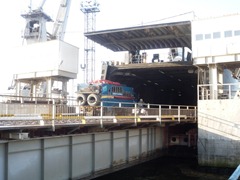
We had a wonderfully smooth crossing, with bright sunshine on deck and a cooling breeze which made it a very pleasant place to sit and read and watch the Caspian Sea float by. Arguably a lake, the Caspian Sea is landlocked, fed mainly by the Volga River, and is approximately 28 metres below sea-level. It is bordered by Azerbaijan, Iran, Turkmenistan, Kazakhstan and Russia, and as well as being a rich source of oil and gas, it is also claimed that it is the source of 90% of the world’s caviar including the famous beluga caviar.
After a lunch of hotdogs, and a dinner of pot noodle (the only cooking facility available to us on the ferry was an electric kettle), most of the group set up their thermarests on the deck and slept under the stars, with the lights of the oil rigs drifting past.
Cocktails on deck, thanks Captain Dennis!:
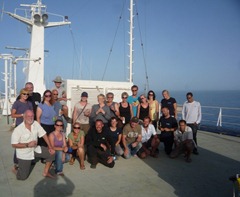
It was about midnight when we dropped anchor and ground to a halt. And there we stayed for 16 hot and breeze-less hours. I am sure you can imagine the excitement when finally we lifted anchor and headed off, but all we did was sail for a further 2 hours before we dropped anchor again. Frustrating and, by now in sight of the port and having been told that we would be pulling into port as soon as the previous ferry had loaded up (although we were to find out in Ashgabat that the real reason was because the port was in lockdown because the President of Turkmenistan was in Turkmenbashi to open a new school – the lockdown was so strict that people staying in hotels in the city were ordered to stay inside with the curtains closed for 2 days), we all spent time looking through the binoculars trying to use all our powers of telepathy to get it to move. Eventually (and it really does feel like a long time when you are just waiting and have no control over what is happening), we started moving again about 10pm, and finally docked at 11pm. Not known for their efficiency, the Turkmenistan border was not as bad as expected and we were finally all through the border, with the truck and our new local guide Dovran, by 2.30am. A short drive away from the port we pulled off the road and set up tents as quickly as possible to try to get some sleep.
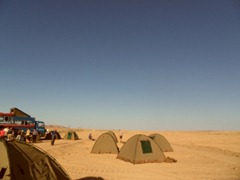
Due to the delays in getting across the Caspian, we had to alter the itinerary slightly in Turkmenistan as the timing of our visas in both Turkmenistan and Uzbekistan dictated what we had time to do. And so it was an early start after only a couple of hours sleep and then we started the drive to Ashgabat. There are really only two main roads in Turkmenistan – one that goes east to west and one that goes north to south – and so road signs are not a major feature on the landscape. As our guide helpfully said, if you are on a big road and heading east then you are heading for Ashgabat.
Ashgabat is a bizarre oasis in the desert. Where we had been driving through villages of dust and poverty, on arriving in Ashgabat you are greeted by gold statues, fountains and French-designed marble buildings. Our hotel was right in the centre of things, and was an unexpected slice of luxury even if the pool was closed for cleaning. The cooler desert night gave people the chance to wander around, although everyone had to make sure they were back in the hotel (or a nightclub, in Ben and Simon’s case) before the 11pm curfew after which time you are not allowed to be walking on the streets. The gawdy flashing neon lights that light up the Arch of Neutrality upon which a gold statue of the former President stands is reminiscent of Las Vegas, and although you are not allowed to take a photo of any government buildings including the Arch from the street, many of the hotel balconies afforded an excellent view!
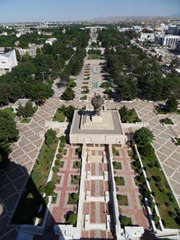
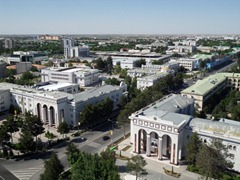
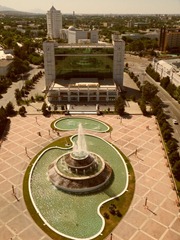
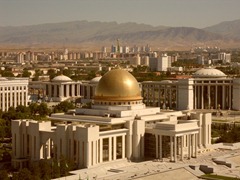
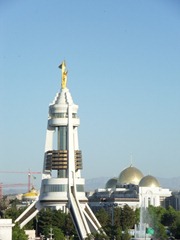
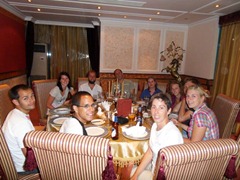
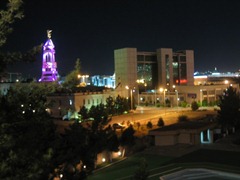
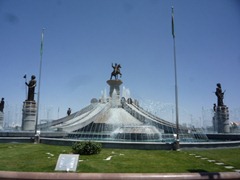
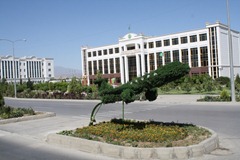
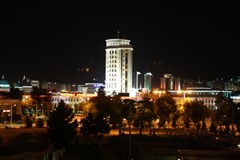
A highlight of our journey through Central Asia is a visit to the Sunday market in Ashgabat. Want to buy a camel? No problem. Spare parts for a Russian tank? Third aisle on the left. Fruit and veg, carpets and clothing, jewellery and cars; almost everything is for sale at the market. It is a really fascinating place to wander around for a couple of hours, so very different from the way we shop in our home countries (England, Scotland, Ireland, Northern Ireland, USA, Australia, New Zealand and South Africa in case you want to know!). A few people walked away with necessities or small souvenirs, but everyone heeded Pete’s advice that there wasn’t room in the truck for a camel.
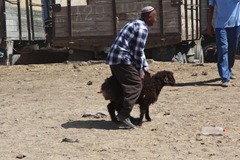
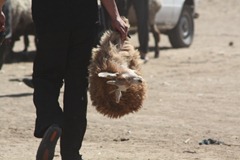

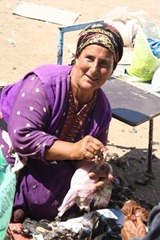
Neill and his new goat friend:
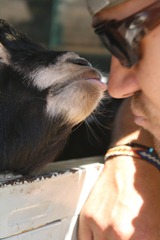

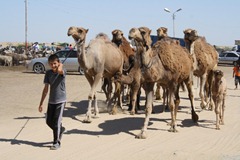
Ashgabat is a desert city and is very very hot even at this time of year – in summer it can reach 55-60 degrees Celsius, we were only experiencing high 30’s early 40’s. The heat affects everyone differently, but unfortunately some of our more active members were quite badly affected and suffered an uncomfortable couple of days.
Heading north from Ashgabat we started to cross the Karakum Desert, said to be the hottest desert in Central Asia. I think we all agree! After an afternoon of driving through sandstorms and past camels and the occasional town, we arrived at our destination, the gas craters of Darvaza. There are three craters – the first is fairly small and filled with water (and the plastic bottle rubbish which is unfortunately a common sight outside of the cities), the second is larger and more impressive with gas bubbling through the mud at the bottom. However the third crater is what we really come here to see and so after setting up camp our local guide organised for a huge 6-wheel-drive Russian truck to come and pick us up and bounce us over the dunes to the crater. Set alight in the 1970’s in order to stop the gas leaking out of the crater in raw form, the burning gas crater is a truly unique sight, the pictures do it more justice than words.

Heather & Alice:
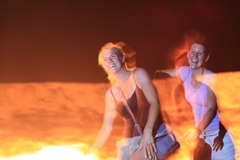
Pete turning into Dennis!
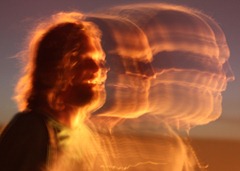
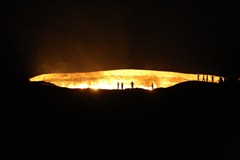
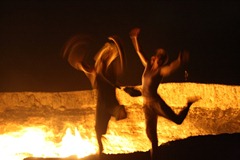
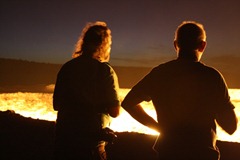
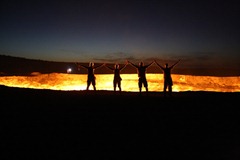
Darrell leaping into the pit of fire (well, not really, just the right camera angle!):
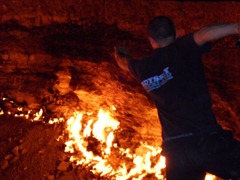

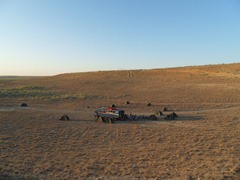
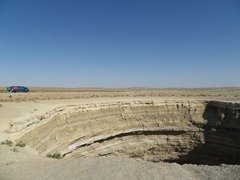
Our journey continued north as we were heading for Moynaq, the former fishing village in Uzbekistan which is now over 60km away from any water thanks to the shrinking of the Aral Sea. But first we had to contend with another border crossing. Our exit from Turkmenistan was uneventful enough, and then we reached the Uzbek border post of Khojeli, a little-used border that had certainly never seen the likes of an overland truck before! After a difficult start when the customs officials took exception to us setting up lunch in their shed (something which we have done with no incident at countless borders before), things were going a bit better until the thorough search of each person’s medications yielded a single valium tablet for which the person carrying it had no prescription. Threats of jail time were bandied around and passports confiscated, but Pete’s patience and friendliness won out and after destroying the tablet and filling in a long report about the efficiency of the border, we were all once again aboard our trusty Calypso, who was not the cause of the delay for the first time!
Continuing north through the desert after a hot night in bushcamp we reached our destination of Moynaq. The sight of fishing boats rusting in a desert is both strange and sad as you consider the whole town’s livelihood was taken away from them when the sea receded, but it is certainly an unforgettable sight.
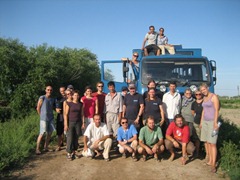
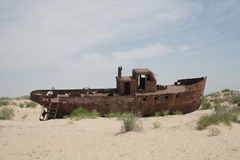
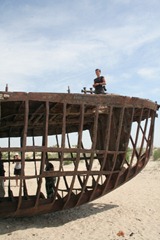
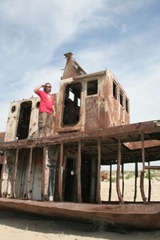
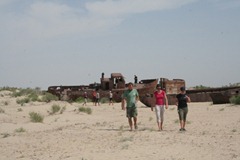
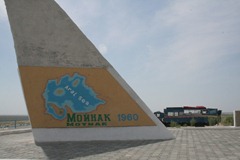
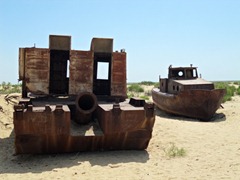
After a very welcome swim in one of the irrigation canals just south of Moynaq we continued further south heading for Nukus, a town with an unexpectedly good art museum. The collection features many works that were banned during Soviet times as they did not conform to the requirement that art should demonstrate the gloriousness of the Soviet ideal (happy workers and all that). Even for those not too interested in art itself, the stories around the pieces were often fascinating and gave an insight into the cultural challenges that artists suffered during those times.
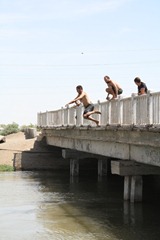
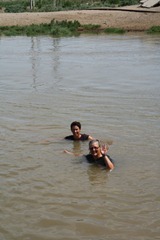
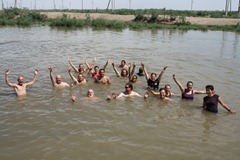
From Nukus we headed to Khiva, the first of the three Silk Road cities we visit in Uzbekistan. After the heat of the desert and some rather hot nights in bushcamp, the prospect of several nights in a hotel with showers and even some air-conditioning was very welcome! Each of the Silk Road cities that we visit has its own personality. In Khiva we stay at a hotel within the old city walls which, together with the minarets and madrassas were restored during Soviet times. As a result of this and the fact that most of the city is set up entirely for tourists, the place feels a bit like a museum or a film set but it provides a great introduction to the history of these cities as you can start to get a feel for what they must have been like in years gone by. Our local guide, Alex, is a wealth of information on the history and architecture of the Silk Road cities and many of the group took advantage of the walking tour which he provided, although the heat (which continued to be in the 40’s) sent some of the group (and the crew!) scurrying for the shade and cold drinks in the internet cafe. Sadly Khiva was where we said goodbye to Darrell who returned to the UK for family reasons, we will miss his chirpiness and ability to make friends wherever he went and always be on a quest for the “stories”.
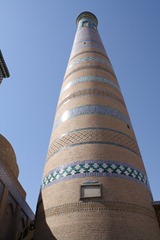
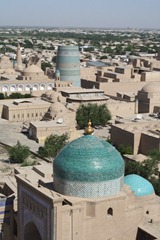
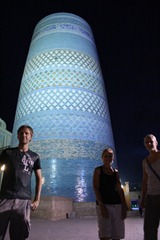
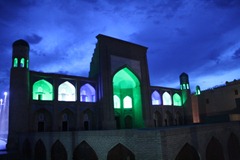
From Khiva it is a fairly long drive to Bukhara through yet more desert! The temperature continued to be in the 40’s, and even the locals seemed to think it was unusually hot... At the height of the Silk Road trading, Bukhara was home to more than 60 caravan-sarais which provided lodging for the traders from India, China, Iran and other countries as they travelled along the largest transcontinental trade path in the history of humanity, connecting Europe and Asia and at times stretching as far as from Rome to Japan. First referred to as the silk roads (there are many paths, Bukhara sits on one of the main ones) by Marco Polo, as the name would suggest, silk was the prime object traded along these routes. At times replacing even gold as a measure of currency, silk could be used to pay for horses, maintenance of servants or even used as a pay-off for crimes committed.
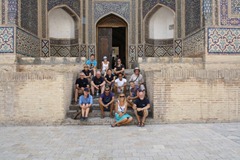

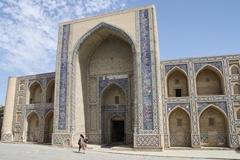
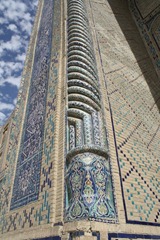
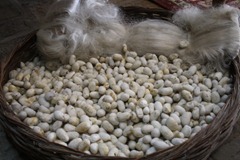
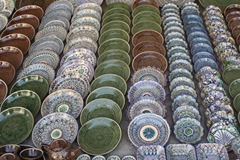
Dennis and Neill:
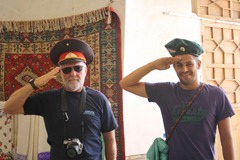
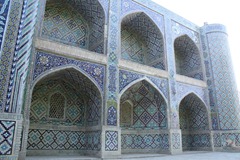
Watching football in the courtyard in front of the hotel:
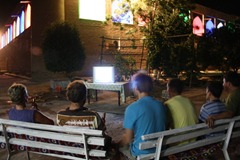
Bukhara is more of a living city than Khiva, again it is home to some beautiful buildings and a huge amount of history, but it seems to be more alive than Khiva as the local people go about their business, shop in the market and eat at the restaurants around the pond. Our hotel was right in the centre of things, built around an old madrassa, breakfast was served on a balcony surrounded by incredible decoration and a distinct air of history (and, happily, a TV in the foyer so the world cup games could be watched! Shame about the results...). Another walking tour was available for those who wished to find out more, and those who braved the heat came back full of knowledge!
Group photo time!
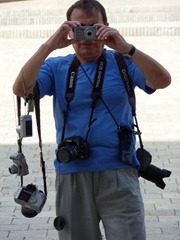
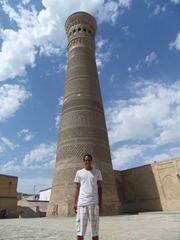

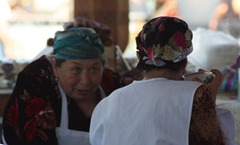
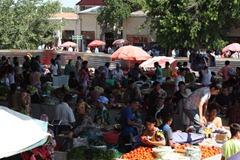
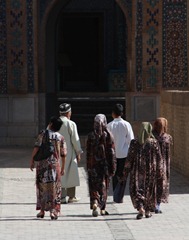
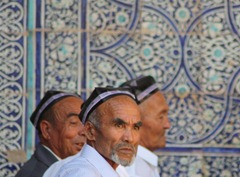
One of the highlights of Bukhara is sitting around the pond at one of the many restaurants and watching the passing parade of locals and tourists, many from other Central Asian countries or other cities within Uzbekistan. Local Uzbek food (well at least the food offered to us as tourists although it does seem the locals are all eating the same as us) can be fairly limited, but often delicious. Shashlik (meat on a skewer), Lagman (noodle soup with meat and vegetables), Shorpa (like Lagman without the noodles), Manti (meat filled dumplings, a cross between ravioli and Chinese dumplings), tomato and cucumber salad (with the ever-present if not slightly unwelcome dill as an accompaniment) and bread are our staples for our time in Uzbekistan, although occasionally a restaurant will offer something slightly different and everyone will jump at it! There are also a few places that offer international food, although sometimes it doesn’t quite live up to expectations, like ordering risotto and getting something resembling fried rice instead.

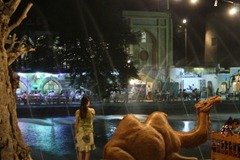
Changing money:
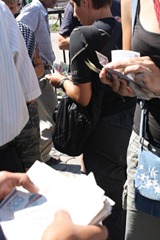
Maggs getting into the swing of things:
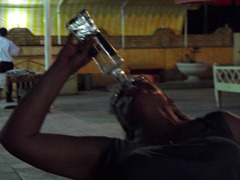
Neill with the equivalent of $50 in local currency… you need a bag just to carry the cash!
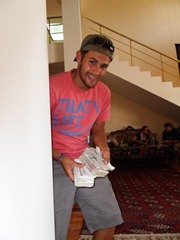
During our time in Khiva and Bukhara the tensions in the southern Kyrgyzstan town of Osh escalated again. We were due to cross from Uzbekistan into Kyrgyzstan at Osh in a week or so. While it is always very difficult to get a true picture of the situation by watching TV news reports which tend to be quite sensationalist, discussions with our local agents in Kyrgyzstan confirmed that the area was best avoided and so it was time to "make a plan", and so we decided upon a small re-routing which would take us from Tashkent in Uzbekistan, into Kazakhstan for a 2-day transit before heading into Bishkek in the north of Kyrgyzstan, far from the regional troubles in Osh. So with Pete off to Tashkent to organise Kazakh visas for everyone, it was time for Kirsten to fly solo on the drive from Bukhara to Samarkand, our final Silk Road city. In Uzbekistan, a country which rarely sees female drivers at all, a female driving a truck is quite a novelty, and caused increased chaos on the roads (more than usual, which is hard to imagine in Uzbekistan, a land of seemingly no road rules!) as other vehicles had to drive alongside us, overtake us and be overtaken by us just to get a good look and wave to us. Even police vans transporting prisoners danced around us for a look and local officials under instruction not to stop foreign registered tourist vehicles let their curiosity get the better of them and pulled us over to find out more!
Samarkand is the most visually impressive of the three cities, with the Necropolis and Registan Square being two of the highlights amongst many. Most of the group joined the city tour and enjoyed the slightly lower temperatures (35 degrees, hard to believe we will all be cold again next week when we are in the mountains of Kyrgyzstan) as they wandered the sights.
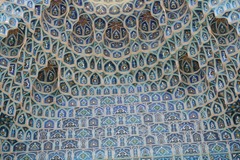
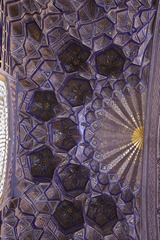
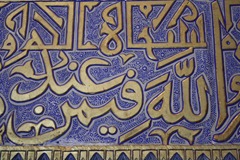
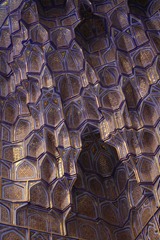
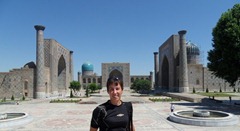
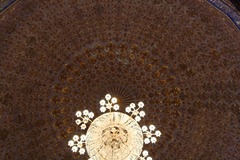
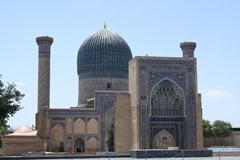
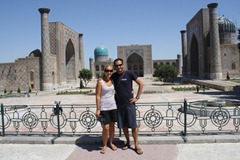
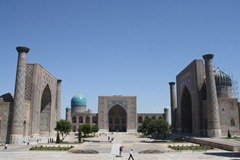
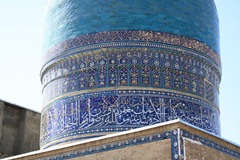
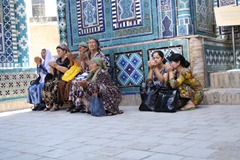
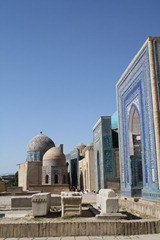
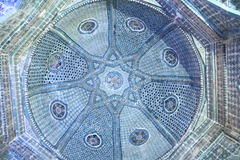
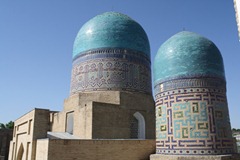
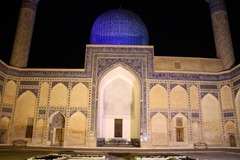
Next stop Kazakhstan... well, first we need the Kazakh Consol to return with the keys to his safe to let us have our passports back and hopefully our visas!
Our optimism at the end of the last blog post that we were going to be boarding the ferry from Baku in Azerbaijan to Turkmenbashi in Turkmenistan that evening was sadly premature. The process of getting onto one of the ferries across the Caspian Sea sounds ridiculous when it is explained to you – there is no schedule, you go down to the port, chat to the port captain, he might say there is a ship due to depart that day but that doesn’t actually mean that there is going to be a ship that day that you are able to board. The ferries can be diverted to Kazakhstan at short notice, or could be loaded with petrol, in which case no passengers are able to be carried. You could be told in the morning that there is no ship, and by that afternoon you could be boarding the ship which has now come into port. Basically total chaos, but all part of the adventure. The once you are on board the fun keeps going; the ship takes approximately 16-20 hours to make the crossing, but then you need to be allowed into port.
And so it was that we found ourselves in Baku for 3 nights rather than just the 1 night that we were originally planning. Baku fuelled by its oil money is a great spot but even a small three star hotel costs US$140. The first ferry that we were due to get on was carrying petrol, so no passengers. The second ferry was diverted to Kazakhstan so not much good to us. To add to the excitement we had only booked one night’s accommodation at the ridiculous cost and now were struggling to get hotel rooms as there was a major oil and gas conference on in the city for 4 days and every hotel was booked to the max. But as always we made a plan after getting hold of our hotel manager we organised enough beds for one of the extra nights (albeit with some thermarests on the floor, not what you would expect in a flash city like Baku, but as we do we made a plan). Then the ferry let us down again and so now for the next plan after more negotiations with the hotel manger tents were put up in the courtyard (well at least for the wise, those who chose to sleep out under the stars provided excellent meals for the local mozi’s with some people looking like they had come down with the measles the next morning). Although we always aim for double / twin share accommodation, everyone was happy to do what needed to be done and share, or camp as required. All part of the adventure, and at least we still had a bathroom and internet! A journey as involved and as off the beaten track as this always has a bit of a twist as we go along, but as is so often said the adventure is best relived after the event and feel fairly certain that our ferry crossing story will be told to many after this epic journey.
At 5am on the last morning in Baku we were spurred into action by a call from Mike, Dennis and Neill who had slept on the truck down at the port with Pete to make sure that the ferry didn’t leave without us. After wiping the sleep from our eyes and gathering up our daypacks we walked down to the port, about a 15 minute walk that was pleasant enough at that early hour when the heat and humidity of Baku has not had a chance to really get going. And then we waited. “Hurry up and wait” was to be a feature of the next 3 days...
By 10am we were all processed out of Azerbaijan, on board the ship and exploring the facilities on the ship. Although the floor plan on display on the wall names a “music hall” and a “cafe”, these are barely recognisable as such and could perhaps be better described as “room with chairs” and “room with chairs and tables where you could maybe get tea”. This is no cross channel ferry or cruise ship! As for the toilets on offer – perhaps better left to the imagination, after a bit of swift negotiation one of the ship’s crew moved out of his en-suite cabin in return for some vodka money and voila, we had secured a more acceptable toilet for the group, or at least one that had been cleaned in the last 3 years...
Calypso boarding the ferry:

We had a wonderfully smooth crossing, with bright sunshine on deck and a cooling breeze which made it a very pleasant place to sit and read and watch the Caspian Sea float by. Arguably a lake, the Caspian Sea is landlocked, fed mainly by the Volga River, and is approximately 28 metres below sea-level. It is bordered by Azerbaijan, Iran, Turkmenistan, Kazakhstan and Russia, and as well as being a rich source of oil and gas, it is also claimed that it is the source of 90% of the world’s caviar including the famous beluga caviar.
After a lunch of hotdogs, and a dinner of pot noodle (the only cooking facility available to us on the ferry was an electric kettle), most of the group set up their thermarests on the deck and slept under the stars, with the lights of the oil rigs drifting past.
Cocktails on deck, thanks Captain Dennis!:

It was about midnight when we dropped anchor and ground to a halt. And there we stayed for 16 hot and breeze-less hours. I am sure you can imagine the excitement when finally we lifted anchor and headed off, but all we did was sail for a further 2 hours before we dropped anchor again. Frustrating and, by now in sight of the port and having been told that we would be pulling into port as soon as the previous ferry had loaded up (although we were to find out in Ashgabat that the real reason was because the port was in lockdown because the President of Turkmenistan was in Turkmenbashi to open a new school – the lockdown was so strict that people staying in hotels in the city were ordered to stay inside with the curtains closed for 2 days), we all spent time looking through the binoculars trying to use all our powers of telepathy to get it to move. Eventually (and it really does feel like a long time when you are just waiting and have no control over what is happening), we started moving again about 10pm, and finally docked at 11pm. Not known for their efficiency, the Turkmenistan border was not as bad as expected and we were finally all through the border, with the truck and our new local guide Dovran, by 2.30am. A short drive away from the port we pulled off the road and set up tents as quickly as possible to try to get some sleep.

Due to the delays in getting across the Caspian, we had to alter the itinerary slightly in Turkmenistan as the timing of our visas in both Turkmenistan and Uzbekistan dictated what we had time to do. And so it was an early start after only a couple of hours sleep and then we started the drive to Ashgabat. There are really only two main roads in Turkmenistan – one that goes east to west and one that goes north to south – and so road signs are not a major feature on the landscape. As our guide helpfully said, if you are on a big road and heading east then you are heading for Ashgabat.
Ashgabat is a bizarre oasis in the desert. Where we had been driving through villages of dust and poverty, on arriving in Ashgabat you are greeted by gold statues, fountains and French-designed marble buildings. Our hotel was right in the centre of things, and was an unexpected slice of luxury even if the pool was closed for cleaning. The cooler desert night gave people the chance to wander around, although everyone had to make sure they were back in the hotel (or a nightclub, in Ben and Simon’s case) before the 11pm curfew after which time you are not allowed to be walking on the streets. The gawdy flashing neon lights that light up the Arch of Neutrality upon which a gold statue of the former President stands is reminiscent of Las Vegas, and although you are not allowed to take a photo of any government buildings including the Arch from the street, many of the hotel balconies afforded an excellent view!










A highlight of our journey through Central Asia is a visit to the Sunday market in Ashgabat. Want to buy a camel? No problem. Spare parts for a Russian tank? Third aisle on the left. Fruit and veg, carpets and clothing, jewellery and cars; almost everything is for sale at the market. It is a really fascinating place to wander around for a couple of hours, so very different from the way we shop in our home countries (England, Scotland, Ireland, Northern Ireland, USA, Australia, New Zealand and South Africa in case you want to know!). A few people walked away with necessities or small souvenirs, but everyone heeded Pete’s advice that there wasn’t room in the truck for a camel.




Neill and his new goat friend:



Ashgabat is a desert city and is very very hot even at this time of year – in summer it can reach 55-60 degrees Celsius, we were only experiencing high 30’s early 40’s. The heat affects everyone differently, but unfortunately some of our more active members were quite badly affected and suffered an uncomfortable couple of days.
Heading north from Ashgabat we started to cross the Karakum Desert, said to be the hottest desert in Central Asia. I think we all agree! After an afternoon of driving through sandstorms and past camels and the occasional town, we arrived at our destination, the gas craters of Darvaza. There are three craters – the first is fairly small and filled with water (and the plastic bottle rubbish which is unfortunately a common sight outside of the cities), the second is larger and more impressive with gas bubbling through the mud at the bottom. However the third crater is what we really come here to see and so after setting up camp our local guide organised for a huge 6-wheel-drive Russian truck to come and pick us up and bounce us over the dunes to the crater. Set alight in the 1970’s in order to stop the gas leaking out of the crater in raw form, the burning gas crater is a truly unique sight, the pictures do it more justice than words.

Heather & Alice:

Pete turning into Dennis!





Darrell leaping into the pit of fire (well, not really, just the right camera angle!):




Our journey continued north as we were heading for Moynaq, the former fishing village in Uzbekistan which is now over 60km away from any water thanks to the shrinking of the Aral Sea. But first we had to contend with another border crossing. Our exit from Turkmenistan was uneventful enough, and then we reached the Uzbek border post of Khojeli, a little-used border that had certainly never seen the likes of an overland truck before! After a difficult start when the customs officials took exception to us setting up lunch in their shed (something which we have done with no incident at countless borders before), things were going a bit better until the thorough search of each person’s medications yielded a single valium tablet for which the person carrying it had no prescription. Threats of jail time were bandied around and passports confiscated, but Pete’s patience and friendliness won out and after destroying the tablet and filling in a long report about the efficiency of the border, we were all once again aboard our trusty Calypso, who was not the cause of the delay for the first time!
Continuing north through the desert after a hot night in bushcamp we reached our destination of Moynaq. The sight of fishing boats rusting in a desert is both strange and sad as you consider the whole town’s livelihood was taken away from them when the sea receded, but it is certainly an unforgettable sight.







After a very welcome swim in one of the irrigation canals just south of Moynaq we continued further south heading for Nukus, a town with an unexpectedly good art museum. The collection features many works that were banned during Soviet times as they did not conform to the requirement that art should demonstrate the gloriousness of the Soviet ideal (happy workers and all that). Even for those not too interested in art itself, the stories around the pieces were often fascinating and gave an insight into the cultural challenges that artists suffered during those times.



From Nukus we headed to Khiva, the first of the three Silk Road cities we visit in Uzbekistan. After the heat of the desert and some rather hot nights in bushcamp, the prospect of several nights in a hotel with showers and even some air-conditioning was very welcome! Each of the Silk Road cities that we visit has its own personality. In Khiva we stay at a hotel within the old city walls which, together with the minarets and madrassas were restored during Soviet times. As a result of this and the fact that most of the city is set up entirely for tourists, the place feels a bit like a museum or a film set but it provides a great introduction to the history of these cities as you can start to get a feel for what they must have been like in years gone by. Our local guide, Alex, is a wealth of information on the history and architecture of the Silk Road cities and many of the group took advantage of the walking tour which he provided, although the heat (which continued to be in the 40’s) sent some of the group (and the crew!) scurrying for the shade and cold drinks in the internet cafe. Sadly Khiva was where we said goodbye to Darrell who returned to the UK for family reasons, we will miss his chirpiness and ability to make friends wherever he went and always be on a quest for the “stories”.




From Khiva it is a fairly long drive to Bukhara through yet more desert! The temperature continued to be in the 40’s, and even the locals seemed to think it was unusually hot... At the height of the Silk Road trading, Bukhara was home to more than 60 caravan-sarais which provided lodging for the traders from India, China, Iran and other countries as they travelled along the largest transcontinental trade path in the history of humanity, connecting Europe and Asia and at times stretching as far as from Rome to Japan. First referred to as the silk roads (there are many paths, Bukhara sits on one of the main ones) by Marco Polo, as the name would suggest, silk was the prime object traded along these routes. At times replacing even gold as a measure of currency, silk could be used to pay for horses, maintenance of servants or even used as a pay-off for crimes committed.






Dennis and Neill:


Watching football in the courtyard in front of the hotel:

Bukhara is more of a living city than Khiva, again it is home to some beautiful buildings and a huge amount of history, but it seems to be more alive than Khiva as the local people go about their business, shop in the market and eat at the restaurants around the pond. Our hotel was right in the centre of things, built around an old madrassa, breakfast was served on a balcony surrounded by incredible decoration and a distinct air of history (and, happily, a TV in the foyer so the world cup games could be watched! Shame about the results...). Another walking tour was available for those who wished to find out more, and those who braved the heat came back full of knowledge!
Group photo time!







One of the highlights of Bukhara is sitting around the pond at one of the many restaurants and watching the passing parade of locals and tourists, many from other Central Asian countries or other cities within Uzbekistan. Local Uzbek food (well at least the food offered to us as tourists although it does seem the locals are all eating the same as us) can be fairly limited, but often delicious. Shashlik (meat on a skewer), Lagman (noodle soup with meat and vegetables), Shorpa (like Lagman without the noodles), Manti (meat filled dumplings, a cross between ravioli and Chinese dumplings), tomato and cucumber salad (with the ever-present if not slightly unwelcome dill as an accompaniment) and bread are our staples for our time in Uzbekistan, although occasionally a restaurant will offer something slightly different and everyone will jump at it! There are also a few places that offer international food, although sometimes it doesn’t quite live up to expectations, like ordering risotto and getting something resembling fried rice instead.


Changing money:

Maggs getting into the swing of things:

Neill with the equivalent of $50 in local currency… you need a bag just to carry the cash!

During our time in Khiva and Bukhara the tensions in the southern Kyrgyzstan town of Osh escalated again. We were due to cross from Uzbekistan into Kyrgyzstan at Osh in a week or so. While it is always very difficult to get a true picture of the situation by watching TV news reports which tend to be quite sensationalist, discussions with our local agents in Kyrgyzstan confirmed that the area was best avoided and so it was time to "make a plan", and so we decided upon a small re-routing which would take us from Tashkent in Uzbekistan, into Kazakhstan for a 2-day transit before heading into Bishkek in the north of Kyrgyzstan, far from the regional troubles in Osh. So with Pete off to Tashkent to organise Kazakh visas for everyone, it was time for Kirsten to fly solo on the drive from Bukhara to Samarkand, our final Silk Road city. In Uzbekistan, a country which rarely sees female drivers at all, a female driving a truck is quite a novelty, and caused increased chaos on the roads (more than usual, which is hard to imagine in Uzbekistan, a land of seemingly no road rules!) as other vehicles had to drive alongside us, overtake us and be overtaken by us just to get a good look and wave to us. Even police vans transporting prisoners danced around us for a look and local officials under instruction not to stop foreign registered tourist vehicles let their curiosity get the better of them and pulled us over to find out more!
Samarkand is the most visually impressive of the three cities, with the Necropolis and Registan Square being two of the highlights amongst many. Most of the group joined the city tour and enjoyed the slightly lower temperatures (35 degrees, hard to believe we will all be cold again next week when we are in the mountains of Kyrgyzstan) as they wandered the sights.















Next stop Kazakhstan... well, first we need the Kazakh Consol to return with the keys to his safe to let us have our passports back and hopefully our visas!
Subscribe to:
Posts (Atom)
